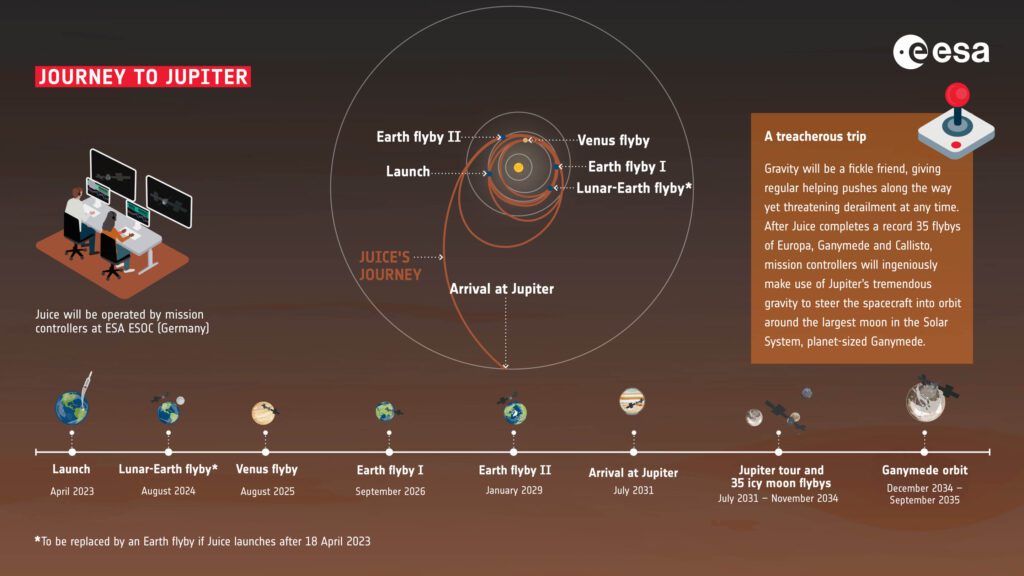
The European Space Agency’s (ESA) Jupiter Icy Moons Explorer, known as Juice, is back on track for its crucial gravity-assist flyby at Venus scheduled for August 31. This follows the successful resolution of a communication anomaly that temporarily severed contact between the spacecraft and Earth.
The issue, which arose during a routine ground station pass on July 16, disrupted Juice’s ability to transmit telemetry data, vital for monitoring its health and status. Thanks to the swift and coordinated efforts of teams at ESA’s European Space Operations Center (ESOC) in Darmstadt, Germany, and the spacecraft’s manufacturer, Airbus, communication was restored just in time for the upcoming Venus encounter.
Juice Falls Silent
The anomaly began when ESA’s deep space antenna in Cebreros, Spain, failed to establish contact with Juice at the expected time of 04:50 CEST on July 16. Initial checks ruled out ground station issues, prompting an escalation to the Juice control team at ESOC. Attempts to reach the spacecraft via ESA’s New Norcia station also failed, confirming that the problem was onboard.
With no signal or telemetry, engineers feared Juice might have entered a survival mode—a last-resort configuration triggered by multiple onboard system failures. In this state, the spacecraft spins slowly, sweeping its antenna across Earth once per hour. However, no such intermittent signal was detected.
“Losing contact with a spacecraft is one of the most serious scenarios we can face,” said Angela Dietz, Juice Spacecraft Operations Manager. “With no telemetry, it is much more difficult to diagnose and resolve the root cause of an issue.”
Attention turned to the communications subsystem. Engineers suspected either a misalignment of Juice’s medium-gain antenna or a failure in the signal transmitter or amplifier. Two recovery strategies were considered: waiting for the next automatic spacecraft reset in 14 days or sending commands ‘blind’ into space, hoping they would be received by one of the backup low-gain antennas.
“Waiting was not an option,” explained Angela. “We had to act fast. Waiting two weeks for the reset would have meant delaying important preparations for the Venus flyby.”
Twenty Hours of Troubleshooting
Blind commanding was a challenging task: Juice was approximately 200 million kilometers from Earth, located on the other side of the sun. Each attempted rescue signal took 11 minutes to reach the spacecraft, with another 11 minutes required to determine success.
After six unsuccessful attempts to steer the medium-gain antenna back towards Earth, recovery efforts continued overnight, lasting almost 20 hours. The focus was on manually powering up Juice’s onboard communication systems. Eventually, a command succeeded in reaching Juice and triggering a response. The command activated the signal amplifier that boosts the strength of the signal Juice sends towards Earth. Contact was re-established, and Juice was found to be in excellent condition. No systems had failed, and all telemetry was nominal.
The root cause was identified as a software timing bug. The software function that switches the signal amplifier on and off relies on an internal timer, which restarts from zero once every 16 months. If the function is using the timer at the exact moment it restarts, the amplifier remains off, weakening Juice’s signal beyond detection from Earth.
“It was a subtle bug, but one that we were prepared to investigate and resolve,” said Angela. “We have identified several possible solutions to ensure this does not happen again and are now deciding which solution would be best to implement.”
All Clear for the Venus Flyby
Despite the high stakes and technical complexity, the recovery by ESA’s mission operations team was achieved with minimal disruption. “This was a textbook example of teamwork under pressure,” said Angela. “Thanks to the team’s calm and methodical approach, we were able to recover Juice without any lasting impact on the mission.”
With the anomaly resolved, the Juice team refocused on preparations for the Venus flyby. Juice will pass its closest point to Venus at 7:28 CEST on Sunday, August 31, completing the second of four planned gravity assists.
Designed for the cold, dark environment of Jupiter, Juice must adapt to the intense solar heat near Venus. To protect its sensitive components, the spacecraft is using its main, high-gain antenna as a thermal shield. Due to thermal constraints, its remote sensing instruments cannot be active during the flyby, so no images of Venus will be captured.
Juice’s Journey to Jupiter
To reach Jupiter directly, Juice would have needed to leave Earth with a velocity of 11 km/s. However, as one of the heaviest interplanetary spacecraft ever launched, at almost 6000 kg, its Ariane 5 launcher provided an escape velocity of only 2.5 km/s.
The spacecraft is using gravity-assist maneuvers to gain the required speed. This week, Juice will use Venus’s gravity to bend its orbit around the sun and increase its speed relative to Earth without using fuel. The Venus flyby will provide a significant boost, setting the stage for Juice’s next encounter with Earth in September 2026, when it will have reached the required Jupiter transfer velocity of 11 km/s.
However, Jupiter will not be in the right position to send Juice out towards it just yet. The spacecraft will use the Earth flyby in 2026 to further fine-tune its trajectory. After one more orbit around the sun, Juice will return to Earth for a final flyby in January 2029. This maneuver will send Juice on a transfer trajectory to intercept Jupiter in July 2031.







